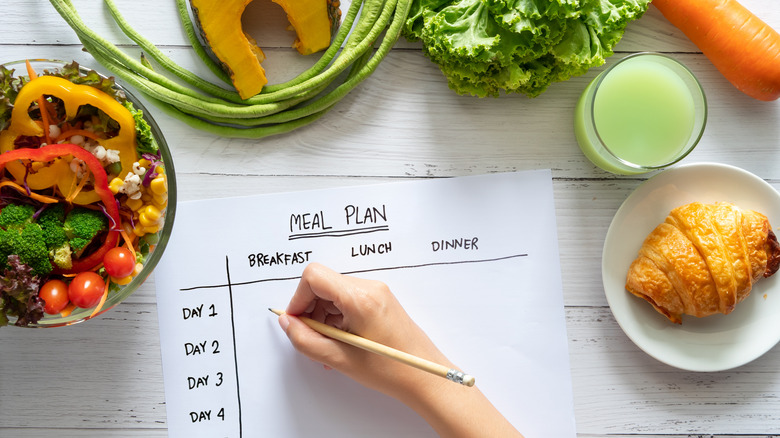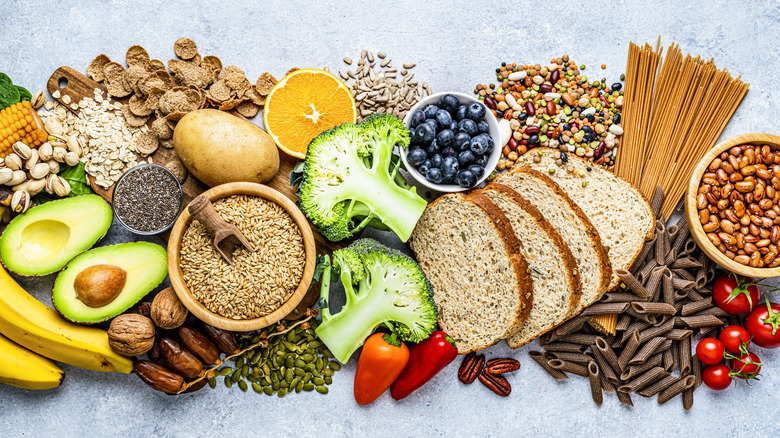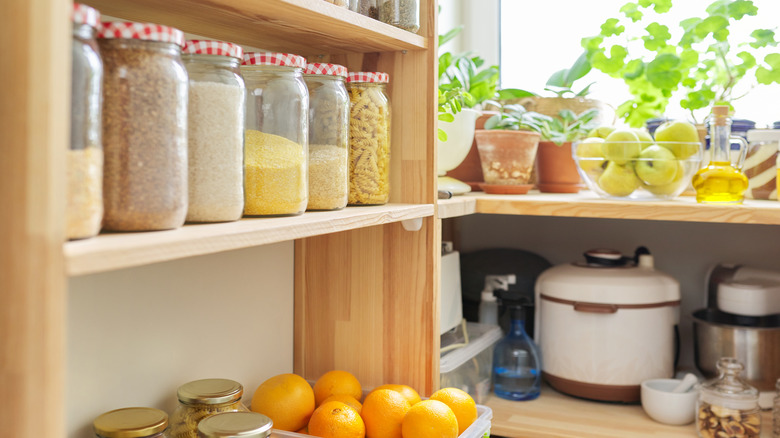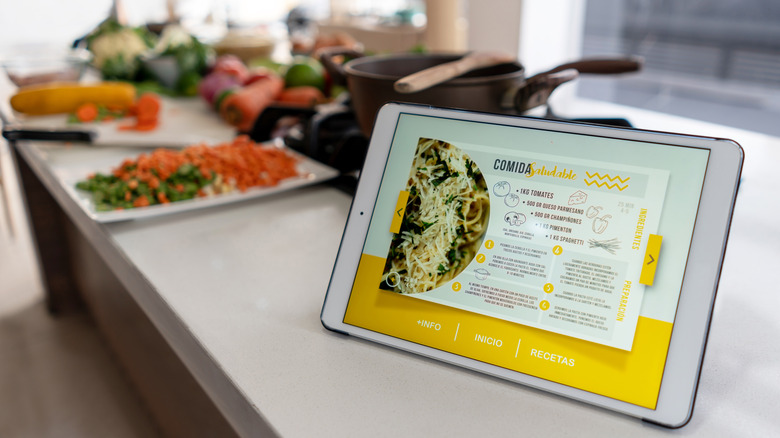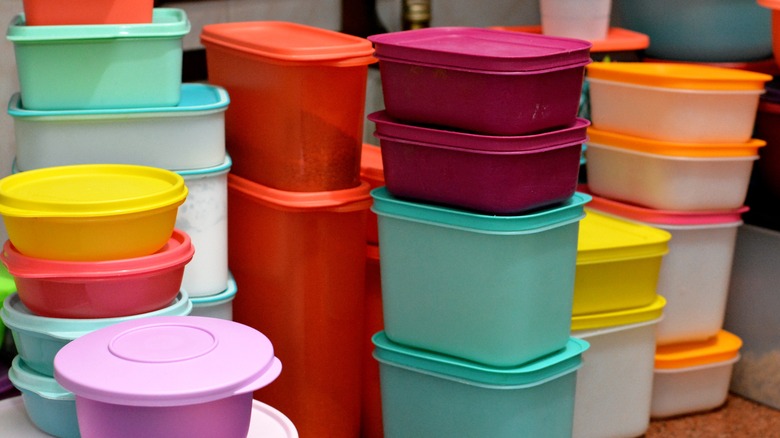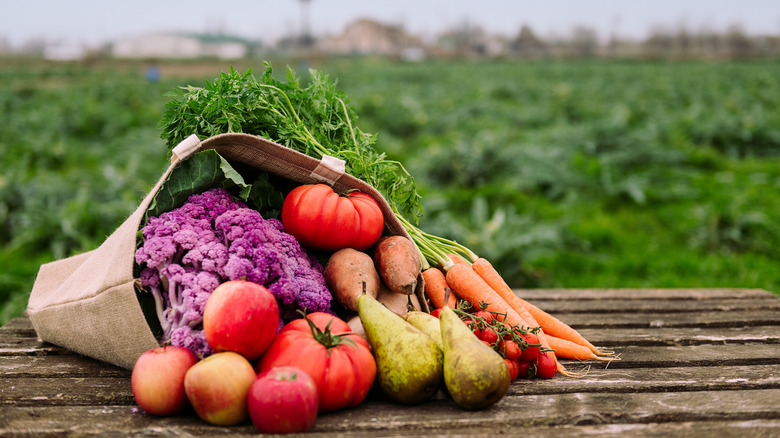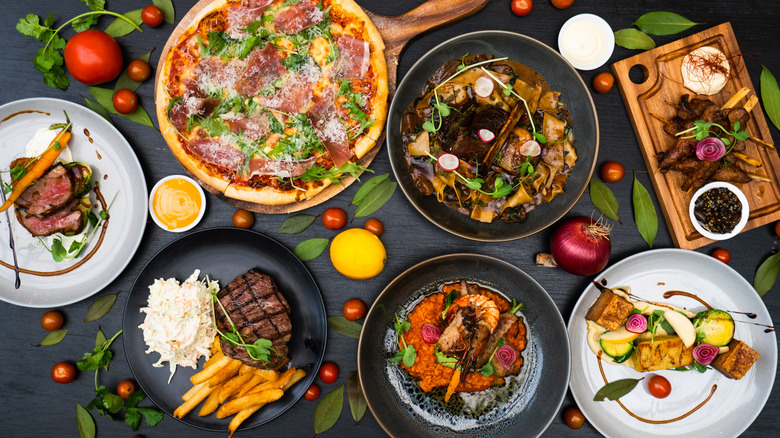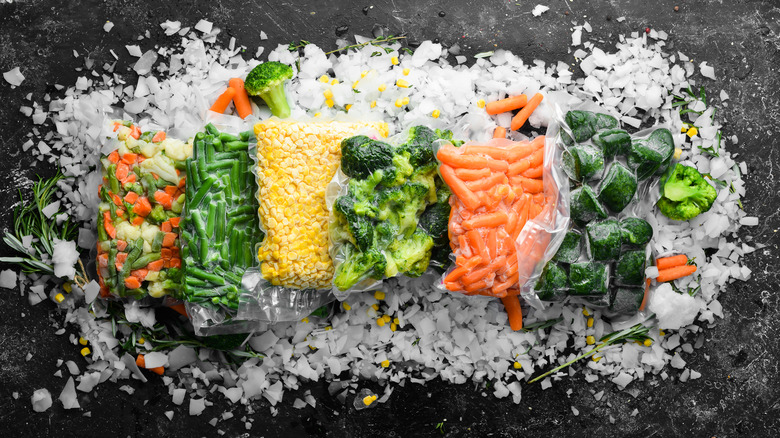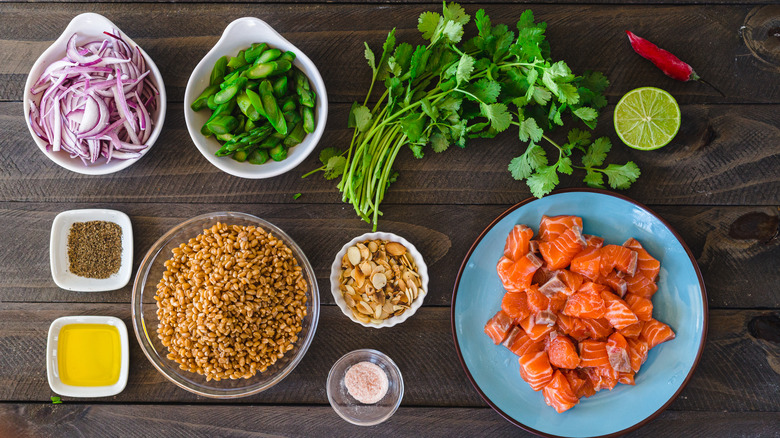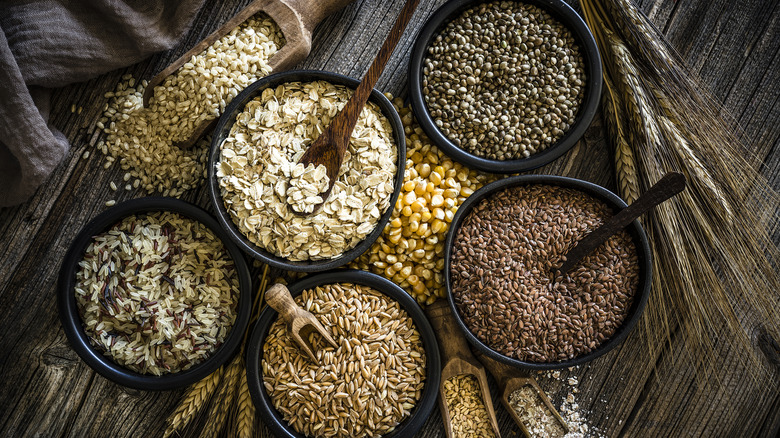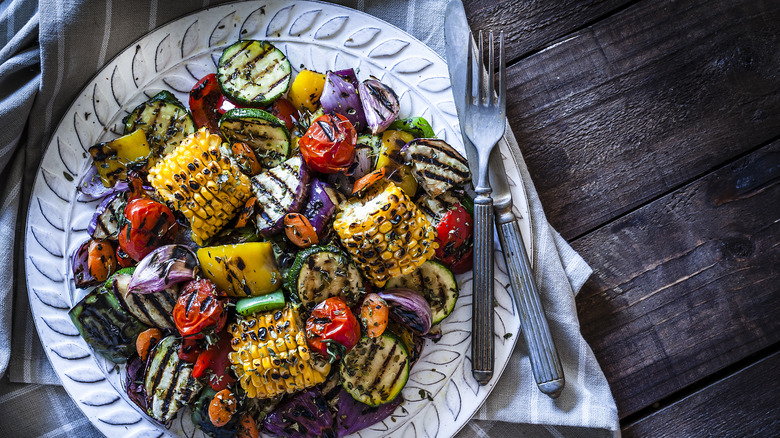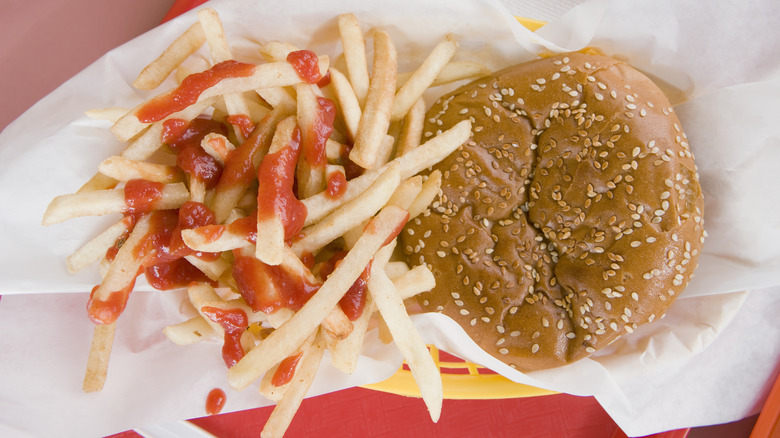How To Plan And Create Balanced Meals, All Week Long
Today's busy families need constant fuel for their lives. When school, work, and extracurricular activities peak, it's easy to forego a home-cooked meal and hit the drive-thru. But even the healthiest fast-food (or fast-casual) restaurants can put a serious dent in your wallet and have short- and long-term health consequences. Even if you're only planning meals for yourself, organization is key.
Fortunately, planning and creating balanced meals all week can be easy and affordable, and better for you than opting for their ultra-high-processed counterparts. Meal planning is a great way to ensure you and your family know what's on the menu without any drama. Deciding what you'll eat a week in advance means you won't fall back on prepackaged meals when time is tight.
Better yet, meal planning is flexible and simple to customize to meet your family's needs. It doesn't matter if you're cooking for vegans or omnivores, for one or 10 people. With a little effort once a week, you can accommodate everyone who comes to your table. Here's everything you need to know to plan and create balanced weekly meals.
Unpack meal planning
Simply put, meal planning involves thinking about all the times you'll eat in a week and deciding what you will cook (or not cook). Think about options for breakfast, lunch, and dinner. You can also use the same meal planning tips for special occasion meals, snacks, and other food obligations (i.e., bringing refreshments for extracurricular activities). Meal planning techniques also work if you have dietary restrictions at home or you're headed out for a long road trip.
If organizing every calorie that crosses your lips for seven days is too much all at once, start with one meal. Whatever you choose depends on your schedule — many people start meal planning with dinners, but some families find their only time to gather is in the morning before everyone heads in different directions. If this sounds like you, start your meal-planning adventure with breakfast. The point is, suss out your family dynamic and think about which meal will make things less stressful. And if you live alone, same thing applies — work with your schedule and plan accordingly.
Also keep in mind that changing your plan is an option if it isn't working. There is no single perfect solution for everyone — all meal plans should be based on your specific needs.
Figure out what you need
There are two aspects to meal planning that need to be addressed before you do anything else. The first is understanding what, exactly, makes a balanced meal. With so much information on eating — some is conflicting, so be careful — it can be challenging to determine what's best for you and your family.
In general, you'll need some form of protein, carbohydrates in the form of whole grains, and fruits or vegetables. Healthy fats from foods like avocado, whole-milk dairy products, nuts, and olive oil are also essential in a balanced diet. Overnight oats, coconut milk, a variety of berries, chia seeds, and chopped nuts are all good items to keep on hand.
Quinoa, chicken, and eggs make quick meals and snacks — so consider stocking up for your meal planning week. Farro is excellent for keeping you full and satisfied without weighing you down. If you like salad dressing, consider making your own — it will cut down on cost, can be healthier than store-bought, and will be a good source for meal planning. (Tip: sheet pan chicken with roasted veggies, planned ahead of time, makes it easy to get on the table fast).
You'll also need to determine how many people you are cooking for and decide your primary focus. Snacks for school? Breakfast? Quick dinner on a busy night?
Consider what you already have
Recipe selection is important, but before making extra trips to the grocery store, take inventory of what's already in your fridge, freezer, and pantry. Many people are amazed to discover exactly how much food they have tucked away.
Make a list of everything you already have and organize it into categories. The first category is your base of grains (rice, oats, quinoa, farro, etc.). Next, check your stock of frozen fruits and vegetables, meats, and canned goods. Browse the pantry for other dry goods like seeds and nuts, pasta, spices, and any quick meals you have (such as mac and cheese or heat-and-serve food pouches).
Add other categories unique to your family, and keep the pantry organized by these categories. You can use what you already have to make some decisions about recipes. This is also a great way to ensure you use the oldest ingredients in your pantry first. And although expiration dates don't always mean what we think they do, rotating ingredients keeps everything fresh and flavorful.
Stock the pantry
Stocking your pantry with staples is an excellent way to cut down on big grocery bills. It also makes it easy to add variety and avoid processed sauces and dressings. So what is in a fully stocked pantry? Again, this will vary depending on your taste, budget, and the types of cuisine you prefer — in general, a well-provisioned pantry should include canned and dried beans, lentils, and rice (regular and microwavable). You'll also want a healthy reserve of canned vegetables like corn and tomatoes.
Other items to consider include anything that makes it easy to whip up a quick last-minute dinner. Pasta sauce, polenta, and olives can be combined to produce a pasta puttanesca that feels like you're dining in Italy. Add stock (chicken or vegetable, olive and peanut oil, and vinegars balsamic, red wine, and apple cider) and you have a well-rounded slate of staples for making tasty lunches and dinners.
Don't forget to load the pantry for meal-planning breakfast and weekend baking projects, too. Oats, flour, nuts, dried fruit, cocoa powder, and sweeteners (such as molasses, maple syrup, or sugar) are the minimum. Consider things such as quality baking chocolate and dried coconut.
It's also important to have onions, potatoes, and garlic — rotate these so they don't spoil. You can add tons of flavor with simple concentrates such as tomato and anchovy paste. Consider a jarred pesto for a punch of flavor.
Take the time to create a master pantry list of common ingredients you use, with space at the bottom for unusual or infrequent purchases. You can keep this as a handy list on your phone. Prefer paper and crossing things off? Type your list onto your laptop and print a new copy each week.
Select recipes
Now the fun begins: selecting recipes. The first rule of recipe selection is to pick meals that are adaptable to you and/or your family's tastes and dietary restrictions. The second rule of recipe selection? That first rule itself is pretty flexible.
Recipes should be safe for all family members, especially those with severe food allergies. But when it comes to keeping things exciting, it's okay to go off-script and include one new recipe a week. It might be a new protein, new cuisine, or new style of cooking an old favorite.
There are some other important things to keep in mind. Choose recipes that make extra, so leftovers do double duty. This allows you to cook one dinner, and lunch the next day. You can also make it easy by utilizing overlapping ingredients — fried rice and rice bowls both use a grain that takes a while to cook, so prep double and save time.
Make sure you cook enough when you are meal planning — of course, "enough" varies depending on your personalized plan, but make sure you have an easy meal every time you need one. Finally, if you're a carnivore, buy meat in bulk. This is likely the most expensive part of your meal planning, so it make sense to save money when you can.
Use a calendar
A calendar is your best friend at this stage. Grab an erasable weekly or monthly calendar and lay out your plan. If you have space on a family or household calendar, that's great. However, a digital calendar might be best for this kind of meal planning, since you'll be filling in a lot of details.
You can have fun, for example, planning vegetarian dinners Tuesdays and Thursdays, and reserving Mondays, Wednesdays, and Fridays for animal protein dinners. While you'll want to plan weekend meals, too, you could leave Saturday and Sunday more flexible.
Whether digital or printed, write down your breakfast, lunch, and dinner for each day of the week — using different color highlights for those meals will help you stay organized. For example, yellow might indicate breakfast each day of the week, blue could be lunch, and green might represent dinner. Having a color-coordinated calendar to quickly glance at the week will make planning and creating your meals less stressful.
A calendar is also an excellent way to determine who you're planning for certain days of the week. For example, if you're planning for a family, but someone will be out one or two nights, note it on the calendar. The more detailed you are the easier you can plan and create balanced meals.
Choose the right containers
The containers you select to store prepped ingredients (or complete meals to-go or to heat up) are important. These keep food fresh and as delicious as the day you prepared it. You have a few options.
Bento box-style metal containers (lightweight and durable) are great for lunches or to prevent food from touching (or to keep sauces separate). Stainless steel is your best bet for durability, but these can be expensive.
Plastic is lightweight and affordable. This might be the only choice if you're sending meals to school with kids who often lose their containers. However, plastic can become stained or scratched, making it a home for bacteria. If you use plastic, choose those that are bisphenol-A (BPA) free, and use them for dried goods only if possible – some foods will stain or deteriorate plastic.
Glass containers are perfect for meal planning that's meant to stay home. Odors and flavors don't linger, so your tamales won't taste like your spaghetti. While glass can be bulky and aren't great for kids, these containers are otherwise a solid choice.
Color-coded containers are the go-to if you're cooking for a variety of diets and need to incorporate flexitarian options. These can also be used for the type of meal (dinner, snacks, etc.) or to indicate dietary restrictions for specific family members (for example, green lids for vegans and orange for those avoiding gluten).
Eat seasonally
Are you looking to save money and get the most nutrition from your meals? Focus your meal planning on foods that are available right now. It may be tempting to rely on frozen foods and stick with produce shipped from across the globe, but even when those are on sale, that strategy can be a budget-busting nightmare. Eating seasonally is more affordable, as produce is often cheaper when it's abundant. Better still, eating local, seasonal food supports farmers who live in your area, which boosts local economy.
There is also some research that indicates fruits and veggies in season are better for you and the environment. Foods in season pack more nutrients, especially when they are local to your area. Those "fresh" apples you buy mid-summer? They are most likely at least nine months old. It's safe to say that nutrition declines rapidly during that year of storage, so even if that shiny Gala apple still has its trademark crunch, it may be the nutritional equivalent of eating a plain cracker.
Mix it up
Don't fall into the rut of cooking the same recipes over and over. This will likely become boring and unsustainable when you or your family crave something different. So how do you bust the boredom but keep things familiar and accessible? Start by cultivating a variety of meals. Once you try out a recipe and it gets the thumbs-up, add it to the rotation. If you follow a general guideline of trying one new recipe a week and half of those pass muster, you'll have 24 new recipes in a year. This makes for a good variety of foods.
Another way to eliminate the eye-rolling when the same meal hits the table too often is to ask for requests. You may be tasked with meal planning and prepping, but everyone likes to have a say. If it's a family you're planning for, ask them for special requests, and incorporate those into the lineup.
And instead of organizing by recipe, pick a theme. Nobody is arguing the greatness of tacos, but plain old beef-n-cheese in a crunchy shell can get a little stale, week after week. If you like Taco Tuesday as a theme, switch up the style of taco every week. At the very least, get a solid five to 10 recipes and rotate through them.
Use your freezer
You might confuse meal prep with meal planning. If you don't want to go through actual meal prep — creating heat-and-eat meals — your freezer is your best friend.
Use the freezer to portion and store prepped staple ingredients for whipping up quick meals a la minute. This can include ingredients that freeze well, such as chopped carrots, onions, and celery, but it goes well beyond those basics. Partially cook and freeze whole lasagnas (or portion into individual servings of fully cooked meals). Freeze nuts and flours to prolong their shelf life, and fruits and veggies to preserve a taste of summer for the middle of the winter. Buying meat in bulk? Divide into individual portions. Do the same with leftovers.
Individual portions of sauce and dressings make it easy to bring variety to meals. Some meal planners use a combination of freezer bags that include a sauce, meat, and grain, and a veggie to put together entire meals that can be pulled out and heated up. Stir fries and pasta dishes are great for this homemade heat-and-eat approach.
You can use a vacuum sealer for long-term storage, but it's also possible to store for longevity without one. Whatever approach you take, label and date everything you put in the freezer. Keep the oldest food in the front of the freezer so it gets used first, and discard anything with excessive freezer burn.
Make meals substantial
Substantial meals are nourishing to the body and soul. Delicious, filling meals start with some form of protein — and there are many ways to incorporate protein into your balanced meal planning.
From beef to the oft adored edamame, it's possible to add protein even if it's not the star of the show. You can easily add chicken to salad and a handful of chopped nuts in oatmeal or yogurt — but there are other ways to meal plan your way to better nutrition. Quinoa or farro mixed into rice for a grain bowl or fried rice and beef slices in cold sesame noodles are easy additions, as are beans and seeds in soups, salads, and pasta dishes and a few slices of avocado added to sandwiches.
Plan for an appropriate portion of protein for all family members. If grilled or roasted chicken is on the menu on Monday, add extra to the grill and serve it on Tuesday in a fresh salad and Wednesday in a delicious soup. Build a plan to cook once for copious leftovers (and less cooking later in the week).
Get your mise en place
If you opt to menu plan without full-on meal prepping, make it easier by getting everything organized before you cook. The term for this is "mise en place" — everything in its place — and it makes throwing together a quick meal simple.
To prep for a day spent executing a meal plan, you'll first read through the entire recipe to know what's needed. Cut proteins into the necessary size, and chop all vegetables (including onions and garlic). Use small cups to measure out spices, blending any sauces or spice mixes as needed. Measure other dry ingredients, then organize those in the order in which you'll use them. Finally, grab all pots, pans, and utensils you'll need for cooking (and any storage containers you'll use for fridge or freezer storage).
All of this occurs before you even turn on the stove. Once you have everything at hand, it's easy to put the recipe together. Mise en place can make cleanup faster, too. Once you've prepped all ingredients, wash your prep tools before you cook. Even if you aren't responsible for dishes, this makes winding down from the meal more pleasant for the person who is.
Choose healthy grains
Grains are a food staple for people around the world, and they are the superstars of meal planning. Easy to cook in large quantities, grains keep well in the fridge (or freezer). But the grains you select matter. There are four categories of grain.
In whole grains, the bran, germ, and endosperm are intact. Refined grains remove the bran and the germ, making them less nutritionally dense (but with a longer shelf life). Enriched grains are refined but have some nutrients added back in — and fortified grains are refined and have additional nutrients added that are not naturally present (like vitamin D or calcium added to orange juice).
For the most nutritionally dense, filling, and satisfying meals, choose whole grains over any other. Some whole grains do double-duty as protein powerhouses and heart-healthy carbs — these are the ones to choose if you want to add bulk to your diet and you're on a budget.
Grains are also an excellent addition to salads and soup for fullness and extra nutrition. Choosing grains like quinoa, amaranth, and farro add vital nutrients to plant-based diets, too.
Eat the rainbow
Fresh veggies are a critical part of meal planning but are also the Achilles heel for many cooks. No one wants to choke down a sad, limp salad at the end of a long week, and many meal plans fail when more food is tossed out than eaten.
Reverse this trend by strategically planning how and when you use a rainbow of vegetables and fruits every week. Choosing in-season veg helps, but you can also use vegetables and fruits in order of sturdiness. Stick with salads of tender lettuce and fresh spring peas early in the week, and save root veg and hardy greens until the end of the week.
Other ways to make sure you get a colorful array of fruits and veggies include buying veggies your family loves and including kids in the prepping process. Washing and repackaging berries immediately keeps them fresh and more appetizing (a vinegar rinse can help, too).
Make them easy to addd to every day meals. For example, roast trays of vegetables and use them in salads, soups, pasta, and even sandwiches all week.
Meal planning don'ts
When a meal plan fails and you find yourself throwing out fresh ingredients and opting for takeout more often than not, it's usually traced back to a few easy-to-remedy mistakes. There's nothing wrong with building in a few takeout meals or ordering in. But when it becomes more of a desperate dinner solution than part of a well-organized plan, it's time to step back and make some changes.
First, don't get too ambitious if you've never meal planned before. Start by thinking about a few weekly dinners and build from there.
Next, pay attention to the calendar. If you plan a homemade meal on a night when no one gets home until late, chances are good you'll skip cooking and order pizza.
Finally, don't follow someone else's plan. Using a meal planning template initially can be very helpful, but trying to replicate another family's system precisely is bound to result in failure. Your family's needs are unique, and another person's elaborate dinners (or simple fare) may not work for you.

